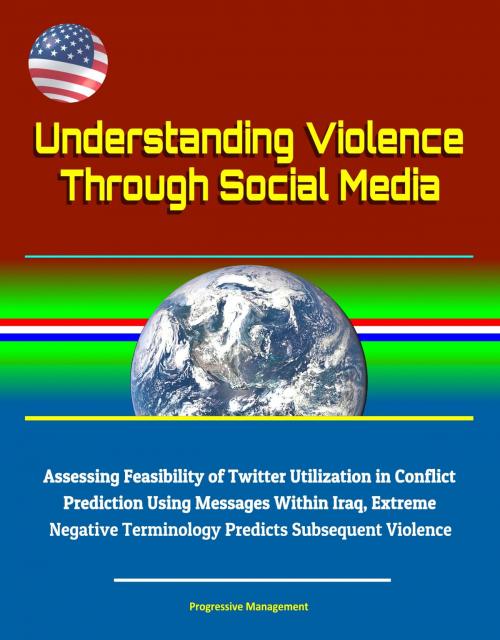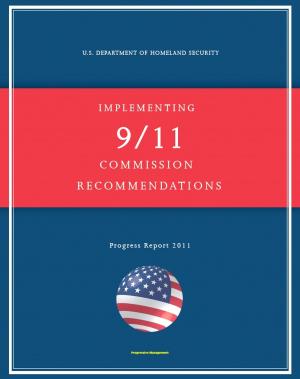Understanding Violence Through Social Media: Assessing Feasibility of Twitter Utilization in Conflict Prediction Using Messages Within Iraq, Extreme Negative Terminology Predicts Subsequent Violence
Nonfiction, History, Military, Computers| Author: | Progressive Management | ISBN: | 9780463189375 |
| Publisher: | Progressive Management | Publication: | July 6, 2018 |
| Imprint: | Smashwords Edition | Language: | English |
| Author: | Progressive Management |
| ISBN: | 9780463189375 |
| Publisher: | Progressive Management |
| Publication: | July 6, 2018 |
| Imprint: | Smashwords Edition |
| Language: | English |
This important December 2017 report has been professionally converted for accurate flowing-text e-book format reproduction.
While social media analysis has been widely utilized to predict various market and political trends, its utilization to improve geospatial conflict prediction in contested environments remains understudied. To determine the feasibility of social media utilization in conflict prediction, we compared historical conflict data and social media metadata, utilizing over 829,537 geo-referenced messages sent through the Twitter network within Iraq from August 2013 to July 2014. From our research, we conclude that social media metadata has a positive impact on conflict prediction when compared with historical conflict data. Additionally, we find that utilizing the most extreme negative terminology from a locally derived social media lexicon provided the most significant predictive accuracy for determining areas that would experience subsequent violence. We suggest future research projects center on improving the conflict prediction capability of social media data and include social media analysis in operational assessments.
I. INTRODUCTION * II. LITERATURE REVIEW * A. SOCIAL MEDIA ANALYSIS AND MILITARY DOCTRINE * B. CONFLICT PREDICTION * C. METHODOLOGY SYNTHESIS * III. BACKGROUND—IRAQ * IV. RESEARCH METHODS * A. HYPOTHESIS * B. DATA AND METHODS * 1. Social Media * 2. Sentiment Dictionary * 3. Analysis Framework * 4. Dependent Variable * 5. Independent Variable * 6. Control Variables * C. REGRESSION ANALYSIS * V. RESULTS * A. FINDING ONE—TWITTER MATTERS * B. FINDING TWO—NEGATIVE SENTIMENT IMPROVES PREDICTIONS * C. FINDING THREE—EXTREME SENTIMENT MATTERS MORE * VI. ADDITIONAL RESEARCH * A. SENTIMENT FOLLOWING VIOLENT EVENTS * B. DOES THE NATURE OF THE CONFLICT MATTER? * C. ARABIC LEXICONS AND TWITTER * VII. CONCLUSION
Social media continues to evolve as a means of sentiment sharing, communication, and social interaction. The interconnectedness of population groups continues to grow with the advancement of mobile device technology and the accessibility of Internet communication infrastructures. This medium provides a constant flow of social tendencies throughout 37 percent of the world's population, which are not limited to benign subjects but also include radical leanings and other forms of social unrest. Analyzing social media trends in key locations of strategic concern could provide an additional tool for conflict prediction.3 Additionally, examining the relationship between social media sentiments and violent events could allow decision makers to be proactive and less reactionary.
Why is this important? Human domain dynamics constantly shift, so the requirement to seek new and inventive ways to gather intelligence on those shifts is imperative. Moreover, the environments where human intelligence is needed most are often the hardest to access physically. The lack of real-time human intelligence in locations with limited access is therefore a serious problem. However, advances in communication technology have also produced new means for maintaining situational awareness. This research seeks to provide insight into human sentiment through social media analysis as a viable solution to this problem. Once we understand the relationship between sentiment and violence in a particular conflict, we can operationalize solutions to curb the occurrence of violence through conflict resolution.
This important December 2017 report has been professionally converted for accurate flowing-text e-book format reproduction.
While social media analysis has been widely utilized to predict various market and political trends, its utilization to improve geospatial conflict prediction in contested environments remains understudied. To determine the feasibility of social media utilization in conflict prediction, we compared historical conflict data and social media metadata, utilizing over 829,537 geo-referenced messages sent through the Twitter network within Iraq from August 2013 to July 2014. From our research, we conclude that social media metadata has a positive impact on conflict prediction when compared with historical conflict data. Additionally, we find that utilizing the most extreme negative terminology from a locally derived social media lexicon provided the most significant predictive accuracy for determining areas that would experience subsequent violence. We suggest future research projects center on improving the conflict prediction capability of social media data and include social media analysis in operational assessments.
I. INTRODUCTION * II. LITERATURE REVIEW * A. SOCIAL MEDIA ANALYSIS AND MILITARY DOCTRINE * B. CONFLICT PREDICTION * C. METHODOLOGY SYNTHESIS * III. BACKGROUND—IRAQ * IV. RESEARCH METHODS * A. HYPOTHESIS * B. DATA AND METHODS * 1. Social Media * 2. Sentiment Dictionary * 3. Analysis Framework * 4. Dependent Variable * 5. Independent Variable * 6. Control Variables * C. REGRESSION ANALYSIS * V. RESULTS * A. FINDING ONE—TWITTER MATTERS * B. FINDING TWO—NEGATIVE SENTIMENT IMPROVES PREDICTIONS * C. FINDING THREE—EXTREME SENTIMENT MATTERS MORE * VI. ADDITIONAL RESEARCH * A. SENTIMENT FOLLOWING VIOLENT EVENTS * B. DOES THE NATURE OF THE CONFLICT MATTER? * C. ARABIC LEXICONS AND TWITTER * VII. CONCLUSION
Social media continues to evolve as a means of sentiment sharing, communication, and social interaction. The interconnectedness of population groups continues to grow with the advancement of mobile device technology and the accessibility of Internet communication infrastructures. This medium provides a constant flow of social tendencies throughout 37 percent of the world's population, which are not limited to benign subjects but also include radical leanings and other forms of social unrest. Analyzing social media trends in key locations of strategic concern could provide an additional tool for conflict prediction.3 Additionally, examining the relationship between social media sentiments and violent events could allow decision makers to be proactive and less reactionary.
Why is this important? Human domain dynamics constantly shift, so the requirement to seek new and inventive ways to gather intelligence on those shifts is imperative. Moreover, the environments where human intelligence is needed most are often the hardest to access physically. The lack of real-time human intelligence in locations with limited access is therefore a serious problem. However, advances in communication technology have also produced new means for maintaining situational awareness. This research seeks to provide insight into human sentiment through social media analysis as a viable solution to this problem. Once we understand the relationship between sentiment and violence in a particular conflict, we can operationalize solutions to curb the occurrence of violence through conflict resolution.















